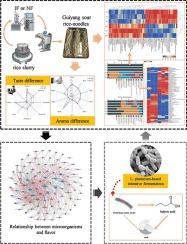以植物乳杆菌为菌源接种发酵贵阳酸米粉,改善了其风味品质
IF 8.2
1区 农林科学
Q1 CHEMISTRY, APPLIED
引用次数: 0
摘要
研究了植物乳杆菌对贵阳酸米粉自然发酵过程中发臭和风味品质不稳定的影响。利用风味组学、代谢组学和微生物组学对其机制进行了探索。结果表明,醇类和醛类是贵阳酸米粉的主要挥发性风味成分。接种发酵(IF)显著增加了这些化合物的浓度,同时通过减少丁酸产生微生物的丰度来减少异味,从而潜在地改善了香气。在IF组中,23种非挥发性风味化合物增加,24种减少,涉及16种代谢途径。相关网络分析显示,植物乳杆菌与醇类、醛类、不饱和脂肪酸、游离氨基酸和有机酸的产生有很强的相关性。以上结果表明,中频技术克服了NF技术的局限性,提高了贵阳酸米粉的风味特征,为优化贵阳酸米粉的生产工艺提供了理论依据。本文章由计算机程序翻译,如有差异,请以英文原文为准。

Lactiplantibacillus plantarum-based inoculated fermentation of Guiyang sour rice-noodles improved its flavor quality
This study investigated the use of Lactiplantibacillus plantarum to fermentation and mitigate the generation of stink and unstable flavor quality during the natural fermentation (NF) of Guiyang sour rice-noodles. The mechanisms were explored using flavoromics, metabolomics, and microbiomics. The results showed that alcohols and aldehydes were the primary volatile flavor compounds in Guiyang sour rice-noodles. Inoculated fermentation (IF) significantly increased the concentrations of these compounds while reducing off-odor by decreasing the abundance of butyric acid-producing microorganisms, thereby potentially improving the aroma. In the IF group, 23 non-volatile flavor compounds increased, while 24 decreased, involving 16 metabolic pathways. Correlation network analysis revealed a strong association between L. plantarum and the production of alcohols, aldehydes, unsaturated fatty acids, free amino acids, and organic acids. These findings suggest that IF overcomes the limitations of NF, enhancing the flavor profile of Guiyang sour rice-noodles and providing a theoretical basis for optimizing its production process.
求助全文
通过发布文献求助,成功后即可免费获取论文全文。
去求助
来源期刊

Food Chemistry: X
CHEMISTRY, APPLIED-
CiteScore
4.90
自引率
6.60%
发文量
315
审稿时长
55 days
期刊介绍:
Food Chemistry: X, one of three Open Access companion journals to Food Chemistry, follows the same aims, scope, and peer-review process. It focuses on papers advancing food and biochemistry or analytical methods, prioritizing research novelty. Manuscript evaluation considers novelty, scientific rigor, field advancement, and reader interest. Excluded are studies on food molecular sciences or disease cure/prevention. Topics include food component chemistry, bioactives, processing effects, additives, contaminants, and analytical methods. The journal welcome Analytical Papers addressing food microbiology, sensory aspects, and more, emphasizing new methods with robust validation and applicability to diverse foods or regions.
 求助内容:
求助内容: 应助结果提醒方式:
应助结果提醒方式:


